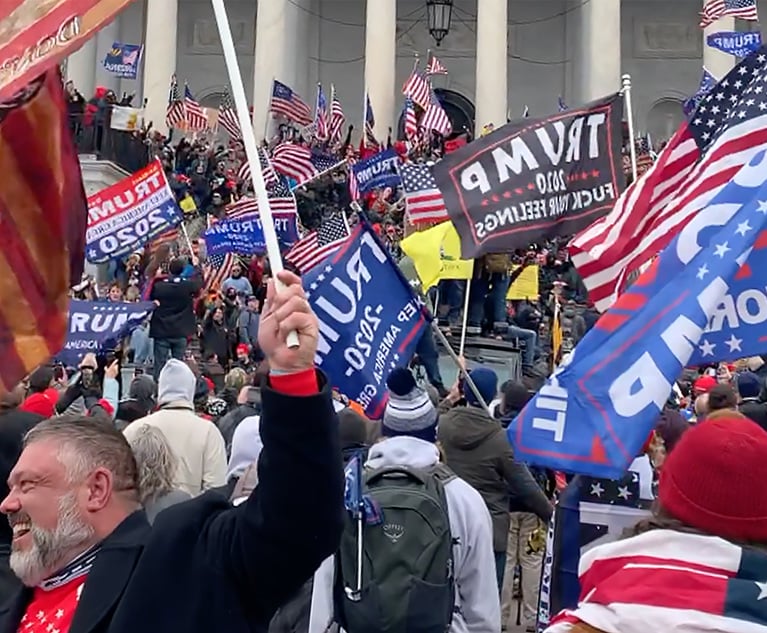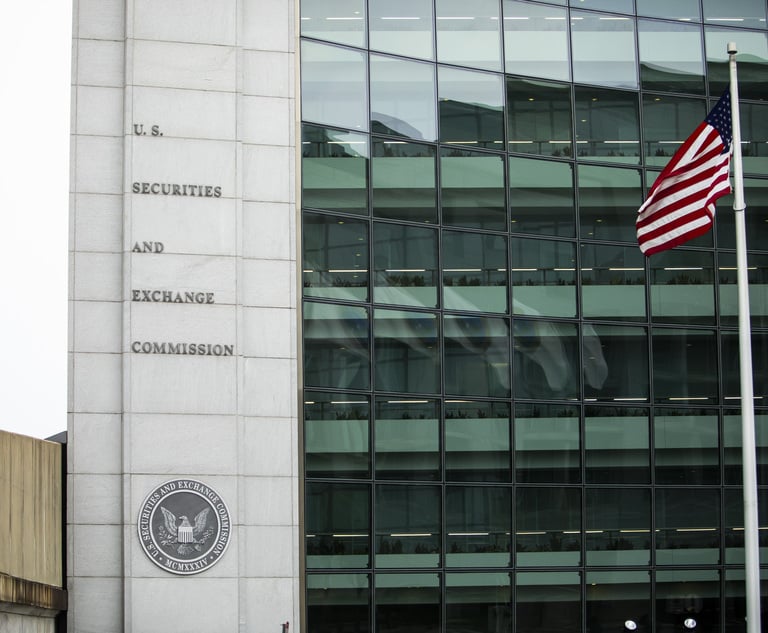Is There Sufficient “Public Purpose” to Take Property For Trump's Wall?
In this Eminent Domain column, Michael Zarin and David Cooper write: "Should President Trump attempt to condemn private property in furtherance of the proposed wall, it will undoubtingly require the courts to revisit the question of when does the government's use of its eminent domain authority violate the “pretext” admonition" in "Kelo v. City of New London."
March 12, 2019 at 02:57 PM
7 minute read
 Michael D. Zarin and David J. Cooper
Michael D. Zarin and David J. Cooper
In order for President Donald Trump to build his wall, the U.S. government will have to use its eminent domain authority to condemn and acquire potentially thousands of acres of private land along the Mexican border. A cornerstone of the government's ability to condemn such property under the Fifth Amendment is its ability to demonstrate that the taking will occur in furtherance of a legitimate public purpose.
In the 2005 case, Kelo v. City of New London, 545 U.S. 469 (2005), the Supreme Court reaffirmed its longstanding policy of accepting the legislative judgment of the government to determine whether taking private land would serve a public purpose, while also recognizing that the government may not take property “under the mere pretext of a public purpose” when the actual purpose of the taking is to “bestow a private benefit.” Should the president attempt to condemn private property in furtherance of the wall, it will undoubtingly require the courts to revisit the question of when does the government's use of its eminent domain authority violate the Kelo “pretext” admonition.
'Kelo'
In the Kelo case, the Supreme Court granted the city of New London broad authority to condemn 90 acres of private property, including the historic homes and property of 15 city residents who filed a lawsuit asserting the taking of their property failed to serve a public purpose. One resident had lived in her home since 1918. Her husband had lived in the same house with her for over 60 years. While acknowledging that the claimants' homes were not located in a “blighted area,” the city declared that the condemnation of their properties would nonetheless serve a public purpose under the auspices of economic redevelopment.
Specifically, the city sought to redevelop the entire 90-acre area with modern residential buildings, R&D office space, restaurants and other riverfront amenities, all of which would support the arrival of a $300 million research facility being built by a large pharmaceutical company on adjacent land. After several years of planning and comprehensive studies of the city's economic needs (it had been designated a “distressed municipality,” and the unemployment rate was nearly double that of the entire state), the city hoped the redevelopment would capitalize on the arrival of the pharmaceutical facility and generate new jobs and tax revenue for the city. Since the claimants' homes “happened to be in the development area” the city determined that taking their property was necessary to complete it's comprehensive redevelopment plan for the area.
Citing its preference for “affording legislatures broad latitude in determining what public needs justify the use of the takings power,” the Supreme Court accepted the city's determination that the condemnation of the claimants' homes served a public purpose. The court's decision was widely criticized at the time as it created a strong presumption of legality to any taking of private property that could be reasonably be tied to a public purpose.
Limited Circumstances
As the New York State Appellate Division for the Second Department observed in 48 WB, LLC v. Village of Haverstraw, 44 A.D.3d 226, 228 (2d Dept. 2007), the Kelo decision granted the government “greater license to interpret the 'public use' of its takings…[and] eminent domain may now represent a growth industry for litigation over the purported public uses which have formed the basis of takings.”
Perhaps sensing the future implications of its ruling, the Supreme Court did suggest in Kelo that there may be limited instances requiring heightened scrutiny of government motives where there is an “unusual exercise of government power [that raises a] suspicion that a private purpose was a foot.”
Since Kelo, several lower courts have found that the Supreme Court's “pretext” standard should be applied in only very limited circumstances. The U.S. Court of Appeals for the Second Circuit in Goldstein v. Pataki, 516 F.3d 50 (2d Cir. 2008), for example, expressly “rejected” the contention of a claimant that the admonition in Kelo against pretextual findings of public purpose requires the courts “in all cases to give close scrutiny to the mechanics of a taking…as a means to gauge the purity of motives of the various government officials who approved it.” The Second Circuit indicated that the Kelo “pretext” standard would only be triggered in the “hypothetical” scenario where:
[T]he circumstances of the approval process so greatly undermine the basic legitimacy of the outcome reached that a closer objective scrutiny of the justification being offered is required.
Goldstein v. Pataki, 516 F.3d at 63 (emphasis original) (citation omitted).
The president's declaration of a national emergency in order to secure wall funding over the objection of Congress may be one of those rare cases that raises a suspicion of a private motive, warranting closer scrutiny.
If consistent with the Administration's case to date in support of its public purpose rationale the government will offer a litany of suspect and manufactured statistical data, backstopped by conclusory and anecdotal evidence, of the so-called “invasion” of drugs, gangs and human traffickers along the border. It will insist that the court cannot second guess its policy findings, as it would constitute an unlawful usurpation of governmental and executive power.
Arguably, Congress' refusal to concede to the president's $5.7 billion request for his wall in accordance with its Article I Constitutional appropriations power, as well as its vote to overrule his emergency declaration, constitutes an equally powerful legislative determination from a co-equal branch of government that a multi-billion dollar investment in a wall would not serve a legitimate public purpose.
Rejecting the president's request is also consistent with polling demonstrating that a large majority of the public does not believe building an expensive wall is in the national interest, as well as the empirical data demonstrating that the overall apprehensions by the Border Patrol at the southern border have dropped precipitously since 2000 and that the number of gang members apprehended is not on the rise according to data maintained by U.S. Customs and Border Protection. (www.cbp.gov/newsroom/stats/cbp-enforcement-statistics).
Judicial Oversight
The competing narratives of two co-equal branches of the government in an area of overlapping jurisdiction will certainly present the courts with a legal and policy dilemma in applying its limited judicial oversight in determining the legitimacy of the president's eminent domain authority concerning the building of the wall.
The seminal question will be whether the court will take the rare action of applying a heightened standard of scrutiny underlying the president's purported public purpose, and have the courage to call it like it is—i.e., that the “national emergency” is nothing more than an attempt to save face on the precipice of the 2020 presidential race after the revelation that the president does not have the power to deliver on his 2016 campaign promise to “build the wall.”
If so, then the Supreme Court must conclude that the government's attempt to use its eminent domain authority to build the wall has nothing to do with a comprehensive immigration plan or emergency, or legitimate public purpose, but instead is predicated on the pretextual motive of enforcing the president's personal political standing, and thus “private benefit.”
The courts have long established that eminent domain authority is a last resort power that should not be abused for personal or private benefit. This is one of those rare and compelling instances where a court will be hard pressed to find that the taking of countless miles of valuable private land to build the president's wall could be legally or morally justified.
Michael D. Zarin and David J. Cooper are partners of Zarin & Steinmetz.
This content has been archived. It is available through our partners, LexisNexis® and Bloomberg Law.
To view this content, please continue to their sites.
Not a Lexis Subscriber?
Subscribe Now
Not a Bloomberg Law Subscriber?
Subscribe Now
NOT FOR REPRINT
© 2025 ALM Global, LLC, All Rights Reserved. Request academic re-use from www.copyright.com. All other uses, submit a request to [email protected]. For more information visit Asset & Logo Licensing.
You Might Like
View All
Private Equity Giant KKR Refiles SDNY Countersuit in DOJ Premerger Filing Row
3 minute readTrending Stories
- 1We the People?
- 2New York-Based Skadden Team Joins White & Case Group in Mexico City for Citigroup Demerger
- 3No Two Wildfires Alike: Lawyers Take Different Legal Strategies in California
- 4Poop-Themed Dog Toy OK as Parody, but Still Tarnished Jack Daniel’s Brand, Court Says
- 5Meet the New President of NY's Association of Trial Court Jurists
Who Got The Work
J. Brugh Lower of Gibbons has entered an appearance for industrial equipment supplier Devco Corporation in a pending trademark infringement lawsuit. The suit, accusing the defendant of selling knock-off Graco products, was filed Dec. 18 in New Jersey District Court by Rivkin Radler on behalf of Graco Inc. and Graco Minnesota. The case, assigned to U.S. District Judge Zahid N. Quraishi, is 3:24-cv-11294, Graco Inc. et al v. Devco Corporation.
Who Got The Work
Rebecca Maller-Stein and Kent A. Yalowitz of Arnold & Porter Kaye Scholer have entered their appearances for Hanaco Venture Capital and its executives, Lior Prosor and David Frankel, in a pending securities lawsuit. The action, filed on Dec. 24 in New York Southern District Court by Zell, Aron & Co. on behalf of Goldeneye Advisors, accuses the defendants of negligently and fraudulently managing the plaintiff's $1 million investment. The case, assigned to U.S. District Judge Vernon S. Broderick, is 1:24-cv-09918, Goldeneye Advisors, LLC v. Hanaco Venture Capital, Ltd. et al.
Who Got The Work
Attorneys from A&O Shearman has stepped in as defense counsel for Toronto-Dominion Bank and other defendants in a pending securities class action. The suit, filed Dec. 11 in New York Southern District Court by Bleichmar Fonti & Auld, accuses the defendants of concealing the bank's 'pervasive' deficiencies in regards to its compliance with the Bank Secrecy Act and the quality of its anti-money laundering controls. The case, assigned to U.S. District Judge Arun Subramanian, is 1:24-cv-09445, Gonzalez v. The Toronto-Dominion Bank et al.
Who Got The Work
Crown Castle International, a Pennsylvania company providing shared communications infrastructure, has turned to Luke D. Wolf of Gordon Rees Scully Mansukhani to fend off a pending breach-of-contract lawsuit. The court action, filed Nov. 25 in Michigan Eastern District Court by Hooper Hathaway PC on behalf of The Town Residences LLC, accuses Crown Castle of failing to transfer approximately $30,000 in utility payments from T-Mobile in breach of a roof-top lease and assignment agreement. The case, assigned to U.S. District Judge Susan K. Declercq, is 2:24-cv-13131, The Town Residences LLC v. T-Mobile US, Inc. et al.
Who Got The Work
Wilfred P. Coronato and Daniel M. Schwartz of McCarter & English have stepped in as defense counsel to Electrolux Home Products Inc. in a pending product liability lawsuit. The court action, filed Nov. 26 in New York Eastern District Court by Poulos Lopiccolo PC and Nagel Rice LLP on behalf of David Stern, alleges that the defendant's refrigerators’ drawers and shelving repeatedly break and fall apart within months after purchase. The case, assigned to U.S. District Judge Joan M. Azrack, is 2:24-cv-08204, Stern v. Electrolux Home Products, Inc.
Featured Firms
Law Offices of Gary Martin Hays & Associates, P.C.
(470) 294-1674
Law Offices of Mark E. Salomone
(857) 444-6468
Smith & Hassler
(713) 739-1250









